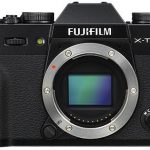The fourth camera in the X100 line-up has arrived and its key new feature is an impressive 24.3-million-pixel sensor. Given that both the X-Pro2 and X-T2 have 24.3-million-pixel sensors, it is only logical that the new Fujifilm X100F would go the same route. Indeed, the 24.3-million-pixel resolution, APS-C, X-Trans sensor of the X100F adds the cherry on top of what is one of the most converted digital cameras ever made.
With, presumably, the same APS-C sensor as the X-Pro2, X-T2 and X-T20, the X100F has a very similar specification in terms of its exposure settings. By default it has a sensitivity range of ISO 200-12,800, with an extended range of ISO 100 – 51,200. The cameras mechanical shutter can shoot from 30-1/4000th sec, and there is also an electronic shutter that can extended the to 1/32,000th sec. For street photographers, or anyone else wanting to remain inconspicuous, the electronic shutter can be used at all speeds, allowing photos to be taken completely silently.
With a vintage rangefinder style, the X100 line-up has always charmed photographers, but behind its pleasing facade is a wealth of technological magic that makes it much more than a pretty face.
Fujifim X100F: Build and Handling
Although the X100F maintains all the vintage charm as its predecessors, that have been a few tweaks to the handling of the camera. The two most important of these are a new control dial, and a small joystick, that has been added to the rear. With the X100F staying as traditional as possible and not having a touchscreen, the joystick is needed to allow the quick selection of the AF point. This is vital as there have been some significant improvements to the AF system compared to the previous X100T.
Fujifilm X100F: Hybrid Viewfinder
Like it predecessors one of the key features of the X100F is its hybrid optical/digital viewfinder. This allows for either purely electronic display, an optical display, or an optical display with digital information overlaid. It really is the best of both worlds.
But even this Hybrid viewfinder has been improved in the new Fujifilm X100F. It now has the ability to show a magnified electronic view for precise manual focusing, in the bottom corner of the optical display. This really could be a game changer for optical manual focusing and we can’t wait to try it out to see just how good it really is.
Fujifilm X100F: AF and Speed
Like the Fujifilm X-T20, which has also just been announced, the start and focusing speeds have been improved. The X100F switches on in just 0.5secs, and has a shutter lag of 0.01secs, and an AF speed of just 0.08 secs, at its very quickest.
Speaking of focusing, the X100F looks to have the identical AF system to the X-T20, with 49 phase detection points, and 91 AF areas, with a total of 325 selectable points. These are huge improvement as the AF was one of the areas where Fujifilm lagged behind many of its competitors.
Fujifilm X100F Lens Specification:
Like it’s predecessors the X100F has Fujinon 23mm f/2 lens (The equivalent field of view as a 35mm lens on a full frame sensor). It is constructed of 8 lenses, in 6 groups, with a single aspherical element. The lens aperture has 9 blades, which should provide nice smooth out of focus areas. Purists will love the fact that the aperture is mechanically controlled via ring on the lens.
Fujifilm X100F: New Lens Adapters
To accompany the new X100F there are two new lenses adapter, the WCL-X100 II wide angle lens converter and the TCL-X100 II telephoto lens adapter. The telephoto adapter as a 1.4x magnification effect, transforming the 35mm (equivalent) lens, to a 50mm (equivalent) lens. Conversely the wideangle adapter has a 0.8x magnification, so the lens becomes equivalent to a 28mm lens on a full frame sensor camera.
Once fitted to the end of the X100F’s lens, the camera recognises that they are mounted and the framing guides in the optical viewfinder are adjusted automatically. The camera can also automatically reduce any chromatic aberration that may occur from using these lenses.
Fujifilm X100F Video:
Unlike the Fujifilm X-T2 and X-T20, the X100F doesn’t shoot 4K video, but if you do plan of shooting some footage of your travels, the X100F doesn’t scrimp on its video specification. It can capture 1920 x 1080p at up to 60fps. Like the rest of this generation of X-series cameras, the in-camera film simulation modes can be used with video capture. There is also the ability to change the exposure whilst shooting.
Fujifilm X100F Price and Availability:
The Fujifilm X100F will be available from 16th February 2017 in Black and Silver, at around £1,249.00






